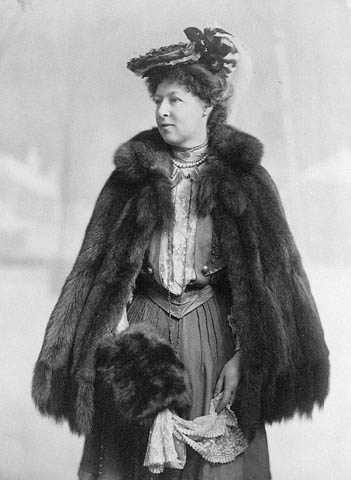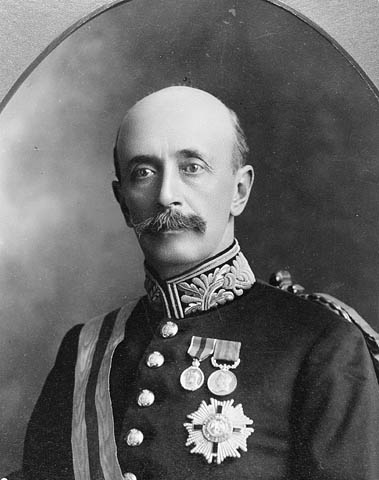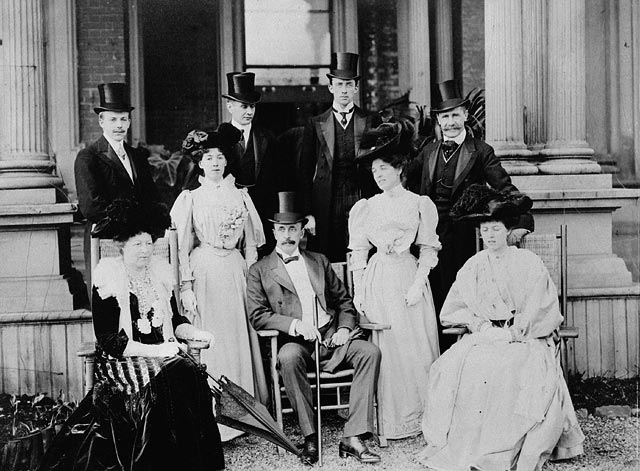
Family and Connections
Albert was the third of six children of General Charles Grey and Caroline Eliza Farquhar. His father, Charles, was the son of the 2nd Earl Grey, who was prime minister of the United Kingdom from 1830 to 1834 and, reputedly, the recipient of a diplomatic gift from China of black tea scented with bergamot oil, which became known as Earl Grey tea. Following a military career that lasted more than two decades, Charles served as a member of Parliament, representing Wycombe in the British House of Commons from 1832 to 1837.
In 1838, Charles accompanied his brother-in-law, John Lambton, 1st Earl of Durham, to British North America, where Durham had been sent by the British government to prepare a report on the Rebellions of 1837. Durham appointed Charles to the Executive Council and Special Council of Lower Canada, which governed Lower Canada until the establishment of the Province of Canada in 1840.
Upon his return to the United Kingdom, Charles became private secretary to Prince Albert, and then to the widowed Queen Victoria. Albert Grey and his siblings, therefore, grew up with close connections to the royal court. Albert became a close friend of the Prince of Wales (the future King Edward VII) and accompanied him on his tour of India in 1875–76. One of his sisters, Louisa McDonnell, Countess of Antrim, became Mistress of the Robes to Queen Victoria, and then to Queen Alexandra. Another sister, Mary, Lady Minto, was viceregal consort of Canada from 1898 to 1904.
Education, Early Career and Inheritance
Albert attended Harrow School for his secondary education, followed by Trinity College Cambridge, where he graduated in 1873 with degrees in history and law. He was elected to the House of Commons in 1880, representing South Northumberland from 1880 to 1885 and Northumberland (Tyneside) from 1885 to 1886. Like Lord Lansdowne, one of his predecessors as governor general of Canada, Grey disagreed with British Prime Minister William Gladstone on the subject of Irish home rule, which resulted in his departure from the House of Commons in 1886. Grey was a friend of Cecil Rhodes, prime minister of Cape Colony (now part of South Africa) from 1890 to 1896, and helped administrate the Rhodes scholarships at the University of Oxford. Grey served as director of the British South Africa Company in the 1890s and administrator of Southern Rhodesia (now Zimbabwe) in 1896–97 during the Second Matabele War.
In 1894, Albert inherited the title of Earl Grey and the Howick estate in Northumberland from his childless uncle, Henry Grey, 3rd Earl Grey, who had served as colonial secretary and supported self-government in British North America.

Marriage and Children
In 1877, Grey married 18-year-old Alice Holford, the daughter of Mary Anne Lindsay and Robert Stayner, an art collector and creator of Westonbirt, The National Arboretum. The couple had five children: Lady Victoria (1878–1907); Lord Charles, 5th Earl Grey (1879–1963); Lady Sybil (1882–1966), a photographer and filmmaker who was invested as an Officer of the Order of the British Empire for her work as a hospital administrator during the First World War; Lady Evelyn (1886–1971); and Lady Lillian (1891–95). Sybil and Evelyn accompanied their parents to Canada and served as ladies-in-waiting to their mother. The death of his youngest daughter, Lillian, may have influenced Grey’s efforts to reduce the infant mortality rate in Canada. As governor general, he visited Canadian farms and discussed efforts to keep milk free from impurities; contaminated milk was a major cause of infant deaths at the time.

Governor General of Canada
In 1904, British Prime Minister Arthur Balfour appointed Grey as governor general of Canada, succeeding Lord Minto (Grey’s brother-in-law). Minto expressed concern privately to his wife, confiding “I doubt Albert’s level-headedness and an enormous amount of harm may be done here by any impetuous action and want of judgement.” Grey’s penchant for making long speeches with flowery language had attracted ridicule in the United Kingdom. British politician and newspaper editor John Morley wrote to Goldwin Smith, a Toronto resident and editor of the Canadian Monthly, stating, “Have we sent you a sufficiently superb windbag to rule over you in Ottawa? I thought grimly of you as I read his flummery in The Times today. I hope Laurier will keep [Grey’s] claws clipped.”
Despite these misgivings, Grey established a strong rapport with Canadian Prime Minister Sir Wilfrid Laurier, who observed that Grey dedicated “his whole heart, his whole soul and his whole life to Canada.” Earl Grey was an avid imperialist who was interested in strengthening Canada’s connections to the wider British Empire. At the same time, he wanted increased Canadian autonomy over domestic matters and the remaining British garrisons in Canada. Grey presented banners of England’s patron saint, Saint George, to Canadian schools “to make all schools imperial minded with such slogans as ‘Ottawa or Winnipeg or Calgary is my home and Empire my Country.” He openly favoured the establishment of a Canadian navy to the extent that the Naval Service Act of 1910 became known as “Grey’s Bill,” especially in Quebec. Grey’s efforts to bring Newfoundland into Confederation, however, were unsuccessful, and the province would not become part of Canada until 1949 (see Newfoundland and Labrador and Confederation).
Grey travelled extensively throughout Canada, visiting every province and meeting Canadians from all social backgrounds. In his speeches, he described both Canada and the wider British Empire in the effusive language for which he was known. He described Lake Ontario as “that beautiful Mediterranean Sea” and praised Hamilton as “Table Mountain and its Bay of Naples.” In an address to the mayor and city council of Ottawa, Grey stated that, in Canada, “The imagination is stirred by the eventful and picturesque story of your past, by the contemplation of your vast territories, by the mysterious and fascinating silence of the undeveloped North, by the varied richness of your boundless resources, by the charm and splendour of your scenery, and by the invigorating magnificence of your unrivalled climate.”
Grey served the longest term of any governor general since Confederation, and he undertook a wide variety of initiatives to promote Canadian culture, landscapes, athletics and sports. He also supported a broad range of Canadian philanthropic organizations. From 1907 to 1911, he sponsored a Dominion of Canada drama and music festival and presented prizes in each category. While the festivals did not continue beyond Grey’s term, his support for the arts in Canada encouraged the development of Ottawa Little Theatre and other community theatres. Grey also admired Canadian literature and met novelist Lucy Maud Montgomery during a visit to Prince Edward Island in 1910. Montgomery recorded in her journal, “Earl Grey shook hands with me and began at once to talk about ‘Anne [of Green Gables]’ and the pleasure it had given him.”
Sports and the Grey Cup
Grey was an enthusiastic amateur athlete with a wide variety of sporting pursuits and hobbies. According to the September 1909 edition of The Busy Man’s Magazine, “Skating and tobogganing parties are held [at Rideau Hall] every Saturday afternoon in the winter season…. He skis, snowshoes or curls. In the summer he plays golf, cricket and does not disdain a good game of lawn bowling. He is a good traveller, fond of fishing…. During an evening, he enjoys a good game of billiards or… bridge.” Grey also sponsored sporting activities and commissioned trophies for Canadian figure skating championships and the Montreal horse show.
He is best known, however, for commissioning the Grey Cup, the trophy awarded to the winning team of the Canadian Football League (CFL) championship. Grey initially intended to commission a trophy for the amateur hockey championships, but when Canadian businessman Sir Montague Allan donated a cup for this purpose, Grey turned his attention to amateur “rugby football.” The first Grey Cup was awarded to the University of Toronto Varsity Blues in 1909. In 1958, the Grey Cup became the trophy of the CFL, and the championship game became known as the Grey Cup match. Grey was posthumously elected to the Canadian Football Hall of Fame in 1963.
The 300th Anniversary of Quebec
Grey spoke French and encouraged English-Canadian and French-Canadian elites to socialize together, observing that “the English people of Montreal would be much gayer and happier and cultured if they allowed a little French sunlight to warm and illuminate their lives.” Senator Raoul Dandurand observed that “[Grey] had endeavoured to promote the use of the French language by the English majority.” Grey received an honorary doctorate of laws from McGill University in 1905.
However, Grey’s involvement in the 1908 celebrations for the 300th anniversary of the founding of Quebec was criticized by the Francophone press. Grey developed a commemorative program before the Canadian government had decided how to mark the occasion. “My proposal is to throw both battlefields into a national park,” he wrote to King Edward VII, “and by doing so to commemorate the two battles in which the two contending races were alternately victorious [Sainte-Foy and the Plains of Abraham], and in both of which the vanquished were entitled to as great honour and glory as the victors.” However, the commemorations — and the accompanying royal visit by the future King George V — appeared to celebrate James Wolfe’s victory at the Battle of the Plains of Abraham in 1759 rather than the founding of Quebec by Samuel de Champlain in 1608. (See also Quebec’s 400th Anniversary.)
Despite the controversy surrounding the tercentennial celebrations, Grey’s program had a lasting impact, resulting in the designation of the Plains of Abraham as a national park and raising half a million dollars toward the establishment of the National Battlefields Commission and Battlefields Park.
Relations with the United States
Grey assumed an active role in Canada’s relationship with the United States, travelling across the border and meeting with President Theodore Roosevelt and his successor, William Howard Taft. Relations between Canada and the United States were strained at the beginning of Grey’s term because of the Alaska boundary settlement of 1903, which favoured American claims to disputed territory. Grey worked closely with successive British ambassadors to Washington to determine the precise international border between Canada and the United States, which resulted in a treaty signed in Ottawa in 1908.
Grey also contributed to negotiations on the North Atlantic fisheries dispute and the Boundary Waters Treaty of 1909, which established each country’s jurisdiction of the Great Lakes and Niagara Falls and established the International Joint Commission to resolve disputes. Both Grey and Roosevelt favoured the establishment of national parks and preservation of the natural world, and they worked together on cross-border conservation initiatives, including the American Bison Society. Grey researched American Civil War battlefield sites, including Gettysburg, in the development of his own Battlefields Park initiative.
Relations with Asia
In 1907, Grey received Canada’s first foreign royal visitor, Prince Fushimi Hiroyasu of Japan, a cousin of the Emperor Meiji. The visit prompted extensive improvements to Rideau Hall, including renovations to the dining room and drawing rooms. Earl Grey and Lady Grey hosted a garden party with Japanese lanterns, while a maple tree at the Central Experimental Farm was dedicated in the prince’s honour. Fushimi travelled across Canada, and Grey instructed municipal leaders that “both the imperial [British] and Canadian governments desired that the visitor be accorded a full state reception and treatment.” Grey hoped that the visit would result in increased trade between Canada and Japan. He wrote to the presidents of Canada’s three railways in 1906, stating “I have been considering for some time what can be done to plant in the stomach of the Orient an increasing desire for Canadian food.”
Grey’s attitudes toward Asian immigration to Canada varied over the course of his term. At first, Grey opposed the head tax imposed in 1885, which restricted Chinese immigration to Canada. He also supported immigration to Canada from India (then part of the British Empire) and Japan (then an ally of the United Kingdom). However, his views changed following the victory of Japan over Russia in the Russo-Japanese War of 1904–05, which was the first example of an Asian power defeating a European power in a modern war. Thereafter, Grey began to see Japan as a threat and favoured methods of effectively limiting Asian immigration to Canada. This included restricting entry to those who arrived by “continuous passage” at a time when direct routes to Canada from Japan and India were unavailable.
Later Life
Upon his return to the United Kingdom in 1911, Grey became president of the Royal Colonial Institute (now the Royal Commonwealth Society) and continued to promote imperial unity to the end of his life. He remained active in philanthropy and the administration of his estates. Grey died of cancer in 1917.

 Share on Facebook
Share on Facebook Share on X
Share on X Share by Email
Share by Email Share on Google Classroom
Share on Google Classroom














